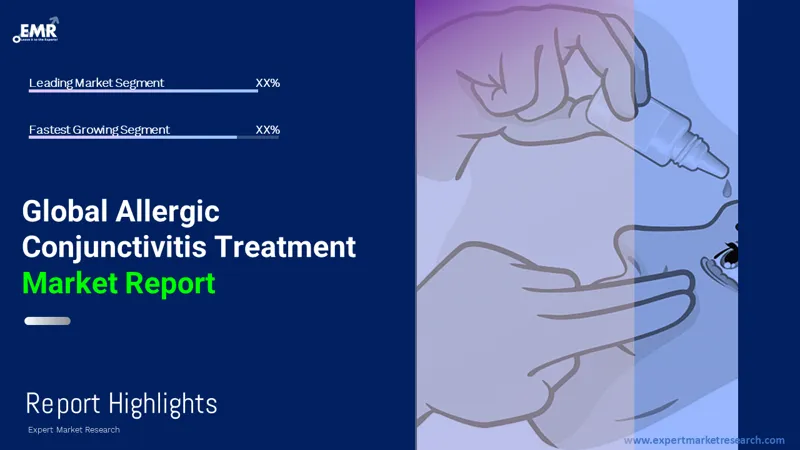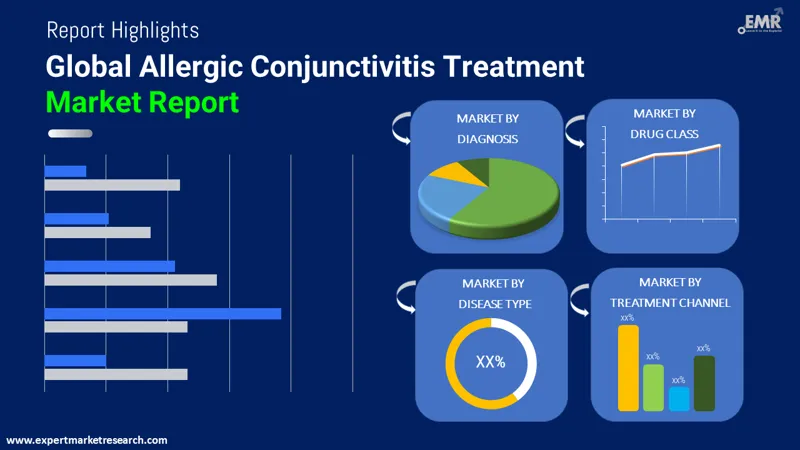
Consumer Insights
Uncover trends and behaviors shaping consumer choices today
Procurement Insights
Optimize your sourcing strategy with key market data
Industry Stats
Stay ahead with the latest trends and market analysis.
Base Year
Historical Year
Forecast Year






The allergic conjunctivitis treatment market size was estimated to be worth USD 8 billion in 2024, driven by the increasing incidences of ocular injuries. The market is expected to rise at a CAGR of 3.95% during the forecast period of 2025-2034. By 2034, the market value is anticipated to be worth USD 11.30 billion.

Read more about this report - REQUEST FREE SAMPLE COPY IN PDF
Allergic conjunctivitis is an ocular allergy caused by foreign agents like household dust, animal dander, pollen, chemical scents, or mould spores. The inflammation in the eye is caused due to an allergic reaction to allergens. Depending on the duration, allergic conjunctivitis can be of two types: Acute and Chronic.
Acute allergic conjunctivitis is the most common type and stays for a short term, while chronic one stays for a year or longer, and symptoms come and go as per the environmental conditions.
The human body produces a potent chemical, histamine in response to any foreign agents. As the allergens enter the eye, the body releases histamine as a defence mechanism. This leads to irritation, itching, and inflammation in the eye.
The diagnosis of the condition is done through eye monitoring and ophthalmological tests. An allergy skin test is also used to confirm the incidence of allergic conjunctivitis. The antibodies produced by the body are detected through blood tests. This is also an effective diagnostic procedure for allergic conjunctivitis disease.
There are no specific treatment guidelines for the management of allergic conjunctivitis. Home care remedies include washing the eyes and applying a cool compress to the eyes. In case of a severe problem, medications are used for the treatment. The anti-histaminic drugs, anti-inflammatory eye drugs, or eye drops can be used to alleviate allergic symptoms.
According to this study, the market can be categorised into the following segments:

Read more about this report - REQUEST FREE SAMPLE COPY IN PDF
Market Breakup by Diagnosis
Market Breakup by Drug Class
Market Breakup by Disease Type
Market Breakup by Treatment Channel
Market Breakup by Region
The increase in the incidence of ocular allergies is the primary reason for market development. Due to rapid urbanisation and rising allergens, the susceptibility to allergic conjunctivitis increases. This is driving the growth of the market.
Increasing awareness has led to more adoption of medications and drugs for the management of ophthalmological problems. This has facilitated the demand of the treatment market. Easy availability and accessibility have also been attributed to the increased allergic conjunctivitis treatment market growth.
Increased investments in research and developmental activities, a major influx of generic drugs and a rising population, are some of the additional factors contributing to the growth of the market.
Among the drug classes, antihistamines are anticipated to have the largest share in the allergic conjunctivitis treatment market. Antihistamines and mast cell stabilizers are the cornerstone therapy for the management of allergic problems. Novel product launches in this drug class are also expected to boost the growth of the market during the forecast period.
North America is expected to have the greatest share in the market owing to the increased prevalence, greater awareness, and presence of significant key players in that region.
Following North America, Europe is projected to dominate among all the regional markets. The factors contributing to this share are more usage of sophisticated medications and the rising patient population.
The Asia Pacific region is anticipated to be the fastest-growing region in the allergic conjunctivitis treatment market. This is attributed to the raising awareness and significant improvements in the healthcare sector.
Allergic Conjunctivitis is caused due to the overreaction of the immune system of the body towards an allergic response. There are different therapeutic options for the management of allergic conjunctivitis depending on the type and severity of the allergy. A major part of therapeutic interventions is also used as a precautionary measure against environmental allergies.
Antihistamines, mast cell stabilisers, and corticosteroids are used to treat allergic symptoms. Drug treatment is the first line of treatment for allergic conjunctivitis. Antihistamines block the secretion of histamines, which are released due to the reaction of an immune system. Oral histamines and eye drops are the two forms of administration. Examples of antihistamines are cetirizine, loratadine, ketotifen and azelastine.
Mast cell stabilisers stabilise the mast cells and take a bit longer time to show their effect. These medications are administered in the form of eye drops. The most used mast cell stabilisers are nedocromil and lodoxamide.
Corticosteroids are only used in case of severe symptoms. These medications reduce inflammation and help in lowering the body’s immune response. These drugs should be used in short term due to their side effects.
There are other additional treatments used for alleviating symptoms. Artificial tears are the oral eye drops used to dilute the allergen and help in its elimination. Cold compresses are applied to provide a soothing effect to the eye and provides a relaxing effect.
The currently available medications and therapeutic interventions are optimal for the management of allergic conjunctivitis. However, preclinical, and clinical studies are under process to discover novel medications that are more effective and have lesser side effects.
Topical steroids are commonly used for managing allergic symptoms. Clinical trials are being done for ester-based steroids, which are anticipated to have fewer adverse effects and better therapeutic potential. Mapracorat is presently under clinical studies. It reduces the uptake of eosinophils and helps in reducing inflammation.
Cyclosporine A is currently under clinical trials for assessing its efficacy and other side effects. The discovery of cyclosporine will reduce the reliance on topical steroids. Clinical studies are under process for determining the optimal cyclosporin concentration for distinct types of allergic conjunctivitis. Researchers are also conducting pre-clinical studies to check drug safety in the paediatric population.
Japan is conducting clinical trials for the ophthalmic application of calcineurin inhibitors. Tacrolimus eye drops are under research and have shown promising results in the early phases of clinical testing. This medication is under advanced testing for further evaluation.
The discovery of these novel therapeutic interventions will assist in the proper diagnosis and treatment of allergic conjunctivitis. The novel product launches will facilitate the expansion of the market.
The report gives an in-depth analysis of the key players involved in the allergic conjunctivitis treatment market, sponsors manufacturing the therapies, and putting them through trials to get FDA approvals. The companies included in the market are as follows:
| REPORT FEATURES | DETAILS |
| Base Year | 2023 |
| Historical Period | 2018-2024 |
| Forecast Period | 2025-2034 |
| Scope of the Report |
Historical and Forecast Trends, Industry Drivers and Constraints, Historical and Forecast Market Analysis by Segment:
|
| Breakup by Diagnosis |
|
| Breakup by Drug Class |
|
| Breakup by Disease Type |
|
| Breakup by Treatment Channel |
|
| Breakup by Region |
|
| Market Dynamics |
|
| Supplier Landscape |
|
| Companies Covered |
|
*While we strive to always give you current and accurate information, the numbers depicted on the website are indicative and may differ from the actual numbers in the main report. At Expert Market Research, we aim to bring you the latest insights and trends in the market. Using our analyses and forecasts, stakeholders can understand the market dynamics, navigate challenges, and capitalize on opportunities to make data-driven strategic decisions.*
Get in touch with us for a customized solution tailored to your unique requirements and save upto 35%!
The market attained a value of USD 8 billion in 2024, driven by the rising incidences of ocular injuries.
The market is projected to grow at a CAGR of 3.95% during the forecast period of 2025-2034 to achieve a value of USD 11.30 billion by 2034.
Allergic conjunctivitis is an ocular allergy caused by foreign agents like household dust, animal dander, pollen, chemical scents, or mould spores.
Corticosteroids, antihistamines, and mast cell stabilisers are the primary drugs used to manage allergic conjunctivitis.
Based on the drug class, the market is segmented into antihistamines and mast cell stabilizers, corticosteroids, among others.
The different regions in the market are North America, Europe, Asia Pacific, Latin America, and Middle East, and Africa.
The two types of allergic conjunctivitis are acute and chronic.
The treatment channels in the market are public and private.
Increasing incidence of ocular allergies, raising awareness and growing investments in the research and development sector are the driving factors in the market.
North America is anticipated to hold a significant share in the market during the forecast period.
The key companies involved in the market are Sun Pharmaceutical Industries Limited, Novartis AG, Bausch & Lomb, AbbVie Inc., Ocular Therapeutix, Inc., Alexion Pharmaceuticals Inc., Santen Pharmaceutical Co., Ltd., Dr. Reddy’s Laboratories Ltd., Alembic Pharmaceuticals Ltd., and Grevis Pharmaceuticals Pvt. Ltd., among others.
Datasheet
One User
USD 3,299
USD 2,969
tax inclusive*
Single User License
One User
USD 5,499
USD 4,949
tax inclusive*
Five User License
Five User
USD 6,999
USD 5,949
tax inclusive*
Corporate License
Unlimited Users
USD 8,199
USD 6,969
tax inclusive*
*Please note that the prices mentioned below are starting prices for each bundle type. Kindly contact our team for further details.*
Flash Bundle
Small Business Bundle
Growth Bundle
Enterprise Bundle
*Please note that the prices mentioned below are starting prices for each bundle type. Kindly contact our team for further details.*
Flash Bundle
Number of Reports: 3
20%
tax inclusive*
Small Business Bundle
Number of Reports: 5
25%
tax inclusive*
Growth Bundle
Number of Reports: 8
30%
tax inclusive*
Enterprise Bundle
Number of Reports: 10
35%
tax inclusive*
How To Order
Our step-by-step guide will help you select, purchase, and access your reports swiftly, ensuring you get the information that drives your decisions, right when you need it.

Select License Type
Choose the right license for your needs and access rights.

Click on ‘Buy Now’
Add the report to your cart with one click and proceed to register.

Select Mode of Payment
Choose a payment option for a secure checkout. You will be redirected accordingly.
Gain insights to stay ahead and seize opportunities.

Get insights & trends for a competitive edge.

Track prices with detailed trend reports.

Analyse trade data for supply chain insights.

Leverage cost reports for smart savings

Enhance supply chain with partnerships.

Connect For More Information
Our expert team of analysts will offer full support and resolve any queries regarding the report, before and after the purchase.
Our expert team of analysts will offer full support and resolve any queries regarding the report, before and after the purchase.
We employ meticulous research methods, blending advanced analytics and expert insights to deliver accurate, actionable industry intelligence, staying ahead of competitors.
Our skilled analysts offer unparalleled competitive advantage with detailed insights on current and emerging markets, ensuring your strategic edge.
We offer an in-depth yet simplified presentation of industry insights and analysis to meet your specific requirements effectively.



Australia
63 Fiona Drive, Tamworth, NSW
+61-448-061-727
India
C130 Sector 2 Noida, Uttar Pradesh 201301
+91-723-689-1189
Philippines
40th Floor, PBCom Tower, 6795 Ayala Avenue Cor V.A Rufino St. Makati City,1226.
+63-287-899-028, +63-967-048-3306
United Kingdom
6 Gardner Place, Becketts Close, Feltham TW14 0BX, Greater London
+44-753-713-2163
United States
30 North Gould Street, Sheridan, WY 82801
+1-415-325-5166
Vietnam
193/26/4 St.no.6, Ward Binh Hung Hoa, Binh Tan District, Ho Chi Minh City
+84-865-399-124
United States (Head Office)
30 North Gould Street, Sheridan, WY 82801
+1-415-325-5166
Australia
63 Fiona Drive, Tamworth, NSW
+61-448-061-727
India
C130 Sector 2 Noida, Uttar Pradesh 201301
+91-723-689-1189
Philippines
40th Floor, PBCom Tower, 6795 Ayala Avenue Cor V.A Rufino St. Makati City, 1226.
+63-287-899-028, +63-967-048-3306
United Kingdom
6 Gardner Place, Becketts Close, Feltham TW14 0BX, Greater London
+44-753-713-2163
Vietnam
193/26/4 St.no.6, Ward Binh Hung Hoa, Binh Tan District, Ho Chi Minh City
+84-865-399-124
Share